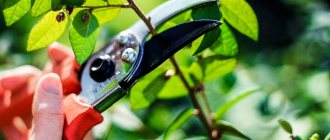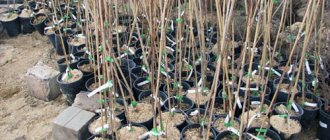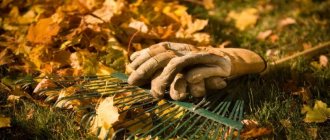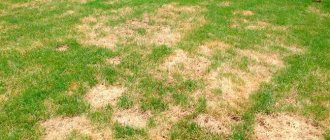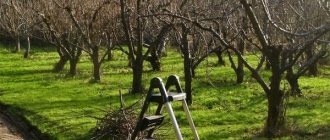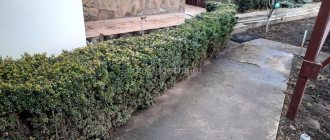Home » Useful information » Tips for beginners
Editor choice
Olga Polyakova 11/14/2019
17120 Views
Usually, when seeing snow-white whitewashed trees (especially in a well-kept garden), the inexperienced viewer has a strong association with putting things in order, clearing away garbage, giving the area a neat appearance and other decorative and aesthetic delights.
But in fact, whitewashing trees is not at all aesthetic. This is one of the important (if not the most important) types of treatment of the outer shell of a tree, helping the plant not only survive the winter, but also stay in good shape throughout the year.
Thanks to a coating of a few millimeters applied to the tree bark, many plant problems that it may encounter during wintering or the off-season are solved. In a sense, whitewash is a protective layer for your plants from various potential dangers: from weather conditions to various types of pests (microorganisms, insects and mammals).
The article comprehensively examines various aspects of the process of whitewashing trees - from the timing of whitewashing to the types of compositions used. Also discussed are the issues of self-production of multi-component whitewashes, various methods of painting trunks and branches, as well as what equipment is needed for this.
The need for whitewashing
Slaked lime is the basis of any whitewash mixture
The bark of a tree is an important organ of the plant that protects the internal layers (cambium and wood) from various external influences. Not only the yield, but also the life of any tree depends on the health of the bark and its ability to perform its functions.
Therefore, if gardeners or summer residents want everything to be fine with their trees, they must take care of their bark. In fact, it is relatively simple: since the bark is outside, the gardener always has access to it.
The bark protects the tree from the following factors:
- adverse weather conditions
- temperature fluctuations
- precipitation and ice
- wind and drafts
- sun rays, which can cause burns in spring
- heat and cold
- rodents (mice, hares) and other pests
- vandalism
Under the influence of these factors, the bark itself becomes vulnerable. It cracks, breaks, wears out, gets sick, etc. To help the bark cope with these impacts, it should be protected.
Whitewashing is one of the main methods of protection. It copes excellently with most of the listed negative impacts (perhaps, except for vandalism), strengthening the various protective properties of the bark.
Garden whitewash
The main component of whitewash is lime, that is, calcium hydroxide. The choice of this substance is not accidental. Thanks to its chemical activity, it provides excellent protection for the trunk from fungi and rodents. The white color of lime reflects sunlight, thereby protecting the bark from burns.
Over time, lime absorbs carbon dioxide from the atmosphere, and its top layer turns into calcium carbonate (which is also white and also scatters sunlight well), the thin crust of which protects the rest of the lime layer from destruction and leaching. Thanks to this, the disinfecting properties of lime are preserved for a long time.
In addition, such a structure has good heat-insulating properties and protects the trunk from frost and temperature changes. Thanks to microcracks in the top layer, it still remains “breathable” and allows air to pass through to the bark.
All trees, regardless of age, must be whitewashed. If there is concern that the thin bark of young trees may be damaged by the chemically active substances that make up the whitewash, there are various methods to combat this phenomenon. To avoid burning the bark, it is recommended to reduce the concentration of lime, use chalk instead, etc.
An important issue accompanying the whitewashing process is determining to what height the trunk should be whitened. Of course, ideally it will be necessary to cover all the branches down to the level of the foliage. But in this case, the material consumption will be too large, and this can be done with too much time.
On the other hand, whitewashing only the standard will not be sufficient. To ensure good safety and protection of the tree, it is recommended to whitewash at least the first tens of centimeters of the main skeletal branches. It is recommended to whiten skeletal branches by 20–30% of their length.
Frequency of whitewashing and recommended periods
Whitewashing trees
It is recommended to whitewash trees in the garden twice a year. Some gardeners recommend doing even three whitewashes:
- Autumn . Considered the main one. Produced in late autumn, just before frost
- Spring . It is classified as repeated or renewing. It is carried out at the very beginning of spring (February-March) in order to enter the off-season with guaranteed protected trees
- Intermediate . Actually another update. Performed in the middle of summer
Of course, whitewashing done in the fall is considered the most effective. If for some reason whitewashing was not carried out at the end of autumn, you should definitely whitewash the trees in the spring, since the most dangerous period for trunks is the February thaw, which may be followed by March frosts.
It is during this period that dark trunks can heat up to +12 °C during the day, which will lead to the first attempts at premature sap flow. But as the sun sets, the weather will take its toll, and the temperature drop to -10 ° C will freeze the sap, even despite the layer of bark.
As a result, long cracks will appear on the trunks, a large number of which significantly impairs the processes of nutrient movement. Whitewashing, thanks to the scattering of sunlight, will prevent the latter from heating the dark bark and triggering sap flow.
It is recommended to begin the whitewashing process in the fall after pruning. The optimal time will be the period when the air temperature drops to plus 4–5 °C.
Whitewashing process in autumn
Some gardeners believe that the timing of painting trees is specific to the species. For example, apple trees should be whitened a month after the end of the fruit harvest, in mid-October, and apricot trees should be whitened 2 weeks after pruning, etc. In any case, all stages of whitewashing should be completed before the first snow falls.
If whitewashing in the fall was not done on time, you will have to whitewash the trunks in February, as soon as the temperature allows.
If everything went well with the whitewashing in the fall, then the protective layer can be reapplied later - at the end of March or beginning of April. Such freedom in timing is explained by the fact that autumn whitewashing has already fulfilled its heat- and light-protective function, and until mid-April there is still no one to protect the crop from - pests are still not able to actively move.
Rodents will also avoid the trunks because the lime concentration remains high for almost a whole year.
Intermediate, or summer, whitewashing is carried out only if the whitewash layer has begun to be washed off by rain or has peeled off. It should not be done if the tree has already begun to bear fruit.
When to whitewash trees
Experienced gardeners recommend performing the procedure twice a year: in autumn and spring.


